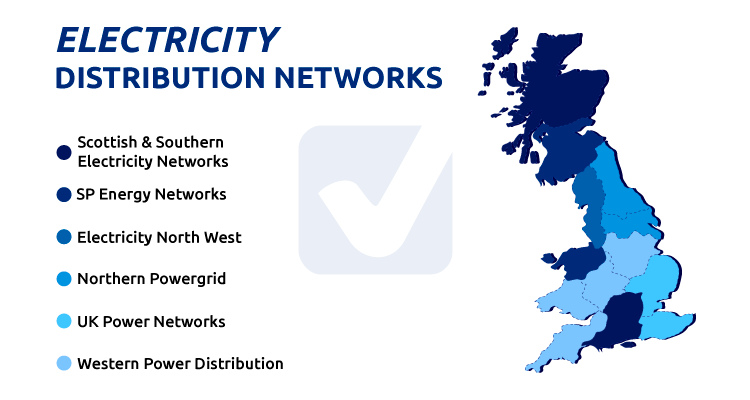Who is my Distribution Network Operator (DNO)?

Sometimes energy companies ask you to talk to your DNO and don’t always explain who or what that is. In our guide, we detail exactly what a Distribution Network Operator is and what they do.
DNO Meaning: What Is a DNO?

A DNO is a company that owns and operates the electricity or gas infrastructure that connects your property to the national grid. A DNO owns the network of towers and cables that carry low-voltage electricity to our homes and businesses from the electricity transmission network.
What Does DNO Stand For?
DNO stands for Distribution Network Operator. DNO is used to describe both electricity network operators and the gas network operators.
Great Britain has 14 different DNO regions. However, they are managed by just six distribution companies, or DNOs.

- Electricity North West serves customers across most of the North West of England.
- Northern Powergrid is the DNO for the North East of England, Yorkshire and northern Lincolnshire. This includes large urban areas such as Leeds, Newcastle and Hull.
- SP Energy Networks is the distribution company that operates the network in Merseyside, Cheshire, North Wales and North Shropshire, as well as in Central and Southern Scotland.
- Scottish and Southern Electricity Networks (SSEN) owns and operates the electricity distribution networks in northern Scotland and central Southern England. The company is a subsidiary of SSE.
- UK Power Networks is the DNO for London, the South East and East of England.
- Western Power Distribution operates the electricity distribution network for Wales, the Midlands and South West England.
What Is an IDNO?

An IDNO is an Independent Distribution Network Operator. These companies own and operate smaller distribution networks that are located within the areas that DNOs serve.
Like DNOs, IDNOs are licensed by energy regulator Ofgem. While IDNOs do not have all the same licence licence conditions as the larger distribution network operators, Ofgem does cap all IDNO charges for customers at a level that is consistent with DNO charges.
The following list contains the current IDNOs in Great Britain:
- Eclipse Power Limited
- Energy Assets Networks Limited
- Last Mile Electricity
- ESP Electricity Limited
- Fulcrum Electricity Assets Limited
- Harlaxton Energy Networks Limited
- Independent Power Networks Limited
- Leep Electricity Network Limited
- Murphy Power Distribution Limited
- The Electricity Network Company Limited
- UK Power Distribution Limited
- Utility Assets Limited
- Vattenfall Network Limited
Who Is My DNO UK?

Who your DNO is will depend on where you live. Unlike energy suppliers where you can choose who offers you the best deal, DNOs are regional monopolies, meaning you cannot pick who you want. Most people do not know who their DNO is, but it is rare that you will have to deal with them since all your bills and enquiries are handled by your energy supplier.
DNO Map
This DNO map (or electricity distribution map) below shows the UK’s 14 electricity network regions and their corresponding distribution network operators.

How do I find my DNO?
You can find your DNO easily via a postcode checker. Simply put in your postcode and you will be given the contact details of both your electricity and gas distribution network operators.
My DNO Contact Number

Although it’s unlikely you’ll need to give your DNO a call, you might need to contact them for infrastructure issues or connections. Your DNO is the company that you would contact for the following reasons:
- To report a power cut
- To receive assistance in an electrical emergency
- To connect a property to the electricity network
- To move your electricity meter
- To report the shroading of overhead lines
- To request tree trimming around overhead lines
- To request network plans showing underground electricity cables
All DNOs have an 0800 number meaning they are free to call. Here’s a table with each operator with their identification and DNO contact number. The Distributor ID, which consists of the first two digits on the second row of your Meter Point Administration Number (MPAN). The distributor ID will range from 10 to 23.
| Area | Distributor ID | DNO | Phone number |
|---|---|---|---|
| North Scotland | 17 | Scottish & Southern Electricity Networks |
0800 048 3515 |
| Central & Southern Scotland | 18 | SP Energy Networks | 0800 092 9290 |
| North East England | 15 | Northern Powergrid | 0800 011 3332 |
| North West England | 16 | Electricity North West | 0800 195 4141 |
| Yorkshire | 23 | Northern Powergrid | 0800 011 3332 |
| Merseyside, Cheshire, North Wales & North Shropshire |
13 | SP Energy Networks | 0800 001 5400 |
| East Midlands, West Midlands, South Wales & South West England |
11, 14, 21, 22 | Western Power Distribution | 0800 096 3080 |
| Eastern England | 10 | UK Power Networks | 0800 029 4285 |
| Central Southern England | 20 | Scottish & Southern Electricity Networks |
0800 048 3516 |
| London & South East England | 12, 19 | UK Power Networks | 0800 029 4285 |
What’s my Meter Point Administration Number (MPAN)? Your MPAN is a unique 21-digit reference code that identifies your electricity meter. It can be found on your bill and is often called your “supply number”. It will have the letter “S” on the left side and two rows of numbers (with eight digits on top and 13 digits on the bottom). If you don’t have a bill on hand, you can contact your electricity supplier to obtain the number.
DNO Power Cuts and Emergencies

In the event of a power cut, we recommend that you also take the following action (if possible):
- See if other areas are affected. Either ask your neighbours or check the street lights.
- Turn off electrical appliances that should not be left unattended. This includes irons and other devices that could cause harm if they restart when the power comes back on.
- Check that the trip switch in your fuse box is turned on. If it is not in the on position, turn off all electrical appliances and attempt to reset the switch.
- Don’t open your freezer. If unopened, some freezers can remain cold for up to 12 hours! In the case that your food spoils, you may be able to file a claim on your home insurance.
- Check on your vulnerable neighbours. Make sure they are warm and have sufficient food supplies.
How Do I Report a Power Cut?
No matter who your DNO is, in the event of an electrical emergency (such as a power cut), you can call 105 to report it. This line is open twenty-four hours a day, seven days a week.
What Is a Gas Distribution Network?

Before gas reaches your home, it must travel through a medium or low pressure distribution network of pipelines, which are usually underground. There are eight gas distribution networks (GDNs) in Great Britain. These are managed by four different gas distribution companies.
In addition to managing the gas pipes, gas distribution companies also provide the gas emergency services for their geographical region.
Reasons you would need to contact the operator of your gas distribution network include the following:
- To report a gas leak
- If you smell gas
- To get connected to the gas mains
- To have your gas meter or pipes moved
- To have your gas meter box installed/replaced (outside only!)
Gas Distribution Companies
The gas distribution companies that manage the network can also be called gas transporters or distribution network operators (DNOs). However, the term DNO is more commonly used to describe electricity distribution companies.
The table below breaks down Britain's four gas distribution companies and their corresponding regions and customer service phone numbers:
| Distributor | Area | Customer service phone number |
|---|---|---|
| Cadent Gas | North West of England, West Midlands, East of England and North London | 0800 389 8000 |
| Northern Gas Networks | North East of England, Northern Cumbria, and much of Yorkshire | 0800 040 7766 |
| SGN | Scotland and Southern England | 0800 912 1700 |
| Wales & West Utilities | Wales and the South West of England | 0800 912 2999 |
Gas Distribution Network Map
The map below shows the gas distribution network a in Great Britain.

What Is an IGT?

Independent Gas Transporters (IGTs) operate and maintain local gas transportation networks. They are connected to the Gas Distribution Network (GDN) via either a system entry point or another IGT.
An estimated one million consumers are connected to IGT networks across Great Britain, with new housing and commercial developments forming the largest share of the IGT market.
The following nine IGTs are currently in operation:
- GTC Pipelines
- Independent pipelines
- ES Pipelines
- Last Mile Gas
- Fulcrum Pipelines
- Indigo Pipelines Limited
- Energy Assets Pipelines Limited
- Murphy Gas Networks Limited
- Leep Gas Networks Limited
How Do I Report a Gas Leak?
No matter who your Gas Distribution Network was, if you smell gas or need to report a gas leak, call 0800 111 999 immediately. This line is open 24 hours a day, seven days a week.








